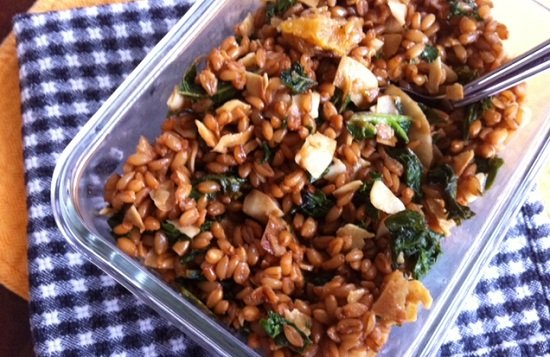 Ask me what my favorite whole grain is, and my unhesitating answer will be, “Farro!” Not that quinoa, barley, oats or rices of various incarnations (brown, black, red, green, wild) don’t play a role in my kitchen, but farro is my true love, lending its appealing nutty chewiness to soups, pilafs, salads…hmmm, I haven’t tried it for breakfast yet!
Ask me what my favorite whole grain is, and my unhesitating answer will be, “Farro!” Not that quinoa, barley, oats or rices of various incarnations (brown, black, red, green, wild) don’t play a role in my kitchen, but farro is my true love, lending its appealing nutty chewiness to soups, pilafs, salads…hmmm, I haven’t tried it for breakfast yet!
Technically, farro refers to a group of three wheat species: spelt (Triticum spelta), einkorn (Triticum monococcum) and emmer (Triticum dicoccum). In practical terms (at least in this country) when you see the word “farro” in the grocery store or on a restaurant menu, it’s emmer that you’re getting. In Italy, that would be “farro medio,” because emmer is roughly medium-sized compared to einkorn (smaller) and spelt (bigger).
Emmer and einkorn are two of the eight Neolithic founder crops, aka the first cultivated crops in the Fertile Crescent region of Southwest Asia (the others are flax, barley, lentils, peas, chickpeas and bitter vetch). It was a daily staple in the diets of the ancient Romans, as well as in the broader Mediterranean and Near East regions. Today, a lot of farro is grown in Tuscany, but the emmer farro I buy is grown right here in Washington state.
Farro started experiencing a resurgence in the late 1990s, but I find that many people still have not heard of it. All three types of farro contain gluten (as do all wheat species), but they contain less gluten than modern wheat varieties, and I’ve anecdotally heard that some people with non-celiac gluten sensitivity can tolerate these ancient forms of wheat. Please note that this would not be true for individuals with celiac disease, for whom there is no known safe level of gluten.
Not sure how to cook farro? Look no further than this definitive Bon Appetit article, “Never over (or under) cook farro again.” For recipe inspiration, try my favorite farro-based salad (with kale) (pictured above) or this recipe for lentil, avocado and farro salad or what about slow-roasted tomatoes and farro. Oldways has some amazing farro recipes on their wonderful website.
Tips for shopping for farro: You want whole grain farro, so avoid “pearled” farro. In Seattle, it’s easy to find in the bulk bins at PCC Natural Markets, Whole Foods and Pacific Food Importers. Bob’s Red Mill sells packaged farro (in stores and online from Amazon and other third-party online stores), and Bluebird Grain Farms sells it in stores (what you buy in bulk bins is probably from them) and via mail order. I haven’t confirmed this recently, but I suspect you can find farro at local farmers’ markets.






